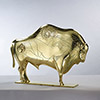EXHIBITED:
Galerie Attali, Paris, 1977
ILLUSTRATED:
Trémois d’un trait, Éditions Michèle Trinckvel, Paris, 1982, black and white illustrated, p.175; color illustrated, pp. 176-177
This sculpture is to be sold with a certificate of authenticity signed by the artist.
Catalogue Note:
Pierre-Yves Trémois was born in Paris in 1921; a truly talented artist devoted his life to art in the fields of sculptures, paintings, ceramics, and jewelry that possessed high level of creativity. Trémois graduated from the Academie des Beaux-Arts in Paris, and at age of 21, Trémois made the debut of his first lithographs exhibition, later in same year he was awarded with the Prix de Rome. In 1948, Trémois received the Prix de la Casa Velasquez award, and was honored to participate in the making of illustrations for the publications of several renowned artists such as Bernard Buffet, Salvador Dali, Léonard Tsuguharo Foujita and many more.
Trémois is passionate in the fields of Biology, Astrology, Poetry and classical literatures; he is in favor for the use of decisive lines and pure black and white colors in depicting silhouettes of the subject-matter, this is in contrasts with the free flow of imagination as exhibited in his works, Trémois particularly employed Charles Darwin’s Theory of Evolution as his source of inspirations; the Theory of Evolution acclaimed that all the complicated species have evolved from simple life forms. Trémois focused his subject on animals, Apes, human lust, creatures of the universe, together, Trémois questioned the origin of the universe by weaving two opposing sides on one piece of work, where conflicts is joined with harmony. For instance, Trémois skillfully engraves fine lines onto uneven harden metalwork; depicting two-dimensional human erotica scenes on the surface of the three-dimensional animal-shaped sculptures, enlightening the viewers to explore a greater possibilities of the two. To Trémois, these bronze sculptures represented the fusion of mankind and animals, the volume and lines are constantly merging and changing. Trémois incorporated the ancient characters, symbols and literatures found in traditional technique of stereotypy specifically to France onto his sculptures.
Trémois thinks that gold is expensive and useless; yet, it would be a perfect material for art creation. Meanwhile, Trémois is deeply interested in Oriental cultures, and has a personal collection of many Asian arts and Japanese antiquities. In 1977, Trémois received a commission request from the Parisian council to create a work that is weighed three tonnes, with length of eight meters for the Metro station of Châtelet-Les Halles in Paris named Energies. The technique and content in Energies act as the prelude to his other 18 bronze sculptures made in the Susse Foundary in Paris that same year. In terms of technicality, not only did Trémois incorporated symbols of Darwin’s Theory of Evolution, moreover, his admiration of painter Dürer’s broad knowledge in perspective drawing, anatomy, copper-engraving have reflected upon the two works of Le Bison Genèse and Le Turbot Aberrant.
Both of the works of Le Bison Genèse and Le Turbot Aberrant could be part of the 300 works, besides part of Trémois’ personal collections, that Trémois planned to donate to the founding of Trémois and Museum of Asian Art back in the 1990, nonetheless, the government of Nice failed to incorporate Trémois as part the establishment, and as a result his personal collections are currently in the collection of Guimet Museum in Paris and Fiji Art Museum in Tokyo. However, there is no doubt that Trémois has left many of the unsolved mysteries and secret coding in both of these works. Horseshoe Crab is one of the mysterious creatures presented in Trémois’ works, its entire body is protected with a hard carapace, two primary compound eyes and a pair of median eyes that can detect both visible light and ultraviolet light, and one pointy long tail that is dated to 450 million years ago, it is considered a living fossil in which it has hardly changed its appearance since then. Seeing a developing embryo moving towards women overlapping one another, or a man and a woman engaged in intimate act have shed the light on nature’s breeding process and constant changes of the universe, they exemplified Trémois’ eagerness in continuous exploration of the universe, scientific studies and academics.


